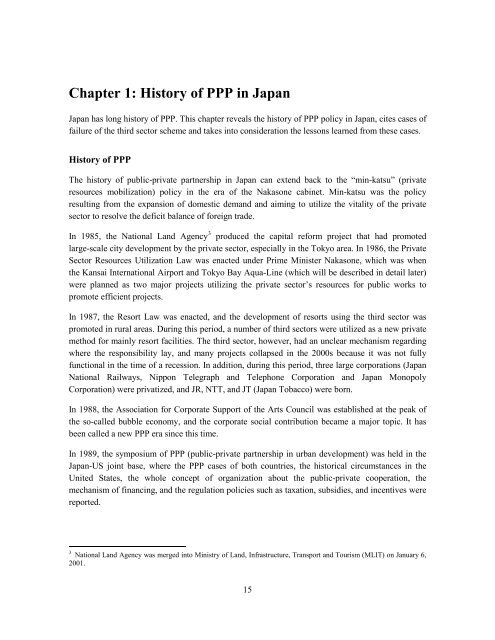Risk Management and Governance for PFI Project ... - Title Page - MIT
Risk Management and Governance for PFI Project ... - Title Page - MIT
Risk Management and Governance for PFI Project ... - Title Page - MIT
Create successful ePaper yourself
Turn your PDF publications into a flip-book with our unique Google optimized e-Paper software.
Chapter 1: History of PPP in Japan<br />
Japan has long history of PPP. This chapter reveals the history of PPP policy in Japan, cites cases of<br />
failure of the third sector scheme <strong>and</strong> takes into consideration the lessons learned from these cases.<br />
History of PPP<br />
The history of public-private partnership in Japan can extend back to the “min-katsu” (private<br />
resources mobilization) policy in the era of the Nakasone cabinet. Min-katsu was the policy<br />
resulting from the expansion of domestic dem<strong>and</strong> <strong>and</strong> aiming to utilize the vitality of the private<br />
sector to resolve the deficit balance of <strong>for</strong>eign trade.<br />
In 1985, the National L<strong>and</strong> Agency 3 produced the capital re<strong>for</strong>m project that had promoted<br />
large-scale city development by the private sector, especially in the Tokyo area. In 1986, the Private<br />
Sector Resources Utilization Law was enacted under Prime Minister Nakasone, which was when<br />
the Kansai International Airport <strong>and</strong> Tokyo Bay Aqua-Line (which will be described in detail later)<br />
were planned as two major projects utilizing the private sector’s resources <strong>for</strong> public works to<br />
promote efficient projects.<br />
In 1987, the Resort Law was enacted, <strong>and</strong> the development of resorts using the third sector was<br />
promoted in rural areas. During this period, a number of third sectors were utilized as a new private<br />
method <strong>for</strong> mainly resort facilities. The third sector, however, had an unclear mechanism regarding<br />
where the responsibility lay, <strong>and</strong> many projects collapsed in the 2000s because it was not fully<br />
functional in the time of a recession. In addition, during this period, three large corporations (Japan<br />
National Railways, Nippon Telegraph <strong>and</strong> Telephone Corporation <strong>and</strong> Japan Monopoly<br />
Corporation) were privatized, <strong>and</strong> JR, NTT, <strong>and</strong> JT (Japan Tobacco) were born.<br />
In 1988, the Association <strong>for</strong> Corporate Support of the Arts Council was established at the peak of<br />
the so-called bubble economy, <strong>and</strong> the corporate social contribution became a major topic. It has<br />
been called a new PPP era since this time.<br />
In 1989, the symposium of PPP (public-private partnership in urban development) was held in the<br />
Japan-US joint base, where the PPP cases of both countries, the historical circumstances in the<br />
United States, the whole concept of organization about the public-private cooperation, the<br />
mechanism of financing, <strong>and</strong> the regulation policies such as taxation, subsidies, <strong>and</strong> incentives were<br />
reported.<br />
3 National L<strong>and</strong> Agency was merged into Ministry of L<strong>and</strong>, Infrastructure, Transport <strong>and</strong> Tourism (MLIT) on January 6,<br />
2001.<br />
15

















